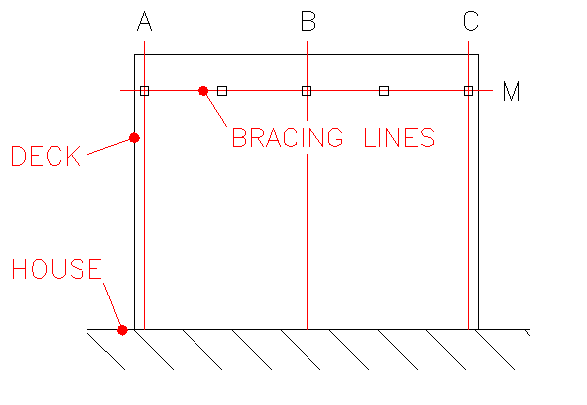More Information about Bracing
The form above simplifies the requirement and design of bracing. This part of the webpage describes more in detail about what goes into the bracing design. The two main points here are:
- The bracing design requires working out the required bracing and how this can be achieved through using bracing elements
- The bracing design involves calculations in both the longitudonal and lateral directions
Bracing design involves bracing for both earthquakes and wind, though for the purpose of decks only the earthquake bracing design is considered as this is always greater than the wind bracing requirements.
Bracing design is worked out using Bracing Units (BU's)
For the purpose of bracing a 2KPa wet in service
Bracing is not required for decks up to 2.0m wide and attached to the wall of a property along one or more walls.
Working out the required bracing
The first step is working out the earthquake zone. In the NZS3604 document under figure 5.4 this outlines the the 4 different earthquake zones for New Zealand. The following table outlines the zones for some of New Zealand's major cities:
| Zone | Locations |
| 1 | Kaitaia, Dargaville, Auckland, Hamilton, Tauranga, New Plymouth, Asburton, Oamaru, Timaru, Dunedin, Invercargil |
| 2 | Taupo, Rotorua, Wanganui, Whakatane, Christchurch |
| 3 | Gisborne, Napier, Hastings, Palmeston North, Masterton, Wellington, Kairkoura, Queenstown |
| 4 | Ward, Moana, Authurs Pass, Milford Sound |
For full details please see NZS3604 figure 5.4.
The second step is working out the soil class, this is either rock, shallow or deep to very soft.
The third step involves working out the bracing requirement from the table 5.8. For the purpose of a deck this classed as a light roofed dwelling with light cladding, light and medium sub floor cladding and a roof pitch less than 25 degrees for the purpose of the table. This gives a rating of 15 BU's per square metre. For decks this rating is halved giving a value of 7.5 BU's per square metre.
The fourth step involves working out the multiplication factor from the bottom of table 5.8 from NZS 3604
| Multiplication Factors | EQ Zone |
| Soil Class | 1 | 2 | 3 | 4 |
| A & B Rock | 0.3 | 0.5 | 0.6 | 0.9 |
| C Shallow | 0.4 | 0.6 | 0.7 | 1.1 |
| D & E Deep to Very Soft | 0.5 | 0.8 | 1.0 | 1.5 |
For an 5.0x4.0m deck with a deep to very soft soil class in Wellington, this would be:
5.0 x 4.0 x 7.5 (from the first part of table 5.8, halved) x 0.8 (the multiplication factor) = 120 BU's
The 120BU's needs to be achieved in both a lateral and longitudonal direction.
Working out the achieved bracing
The bracing can be achieved using an external wall, braced piles & anchor piles. For more information on the braced and anchor piles please see the webpage on posts
For braced and anchor piles these are rated at 120BU's
For an external side, this is rated at 15BU's per metre.
Bracing requirements from NZS3604
From NZS3604 section 5.5 states:
- Bracing lines must not be at more than 5.0m spacings
- Bracing units must be evenly distributed accross the lines of bracing as much as possible.
- Bracing lines in perimeter foundation and subfloor framing, or internal lines
parallel to these (paragraph 5.5.2.1), require not less than the greater of:
- 100BU's
- 50% of the total bracing demand divided by the number of bracing lines
in the direction being considered (along or across).
External subfloor bracing lines (paragraph 5.5.2.2) require not less than
the greater of the two above from paragraph 5.5.2.1 or:
- 15 BUs multiplied by the length in metres of the external wall (For the case for a deck this would imply the external side of a deck).
Bracing Example
| In our example of a 5.0x4.0m deck this requires a minimum of 120BU's. With the deck attached to the house along a 5.0m wall this allows for 50% of the bracing demands to be achieved through the decking posts.
For bracing line A or B, 50% of the bracing demand is required divided by the number of bracing lines in each direction. With a bracing requirement of 120BU's and two bracing lines in that direction, this calculates to a bracing requirement of 60BU's each for bracing line A & B. The calculation for the length of the exterior side (4 x 15BU's) also achieves 60 BU's. But NZS3604 section 5.5 states each bracing line must have a minimum of 100 BU's, so the bracing requirement for lines A & B is 100 BU's.
This can be achieved using either a braced or anchor pile which has a rating of 120BUs, which is in excess of 100BU's.
For bracing line M, 50% of the bracing demand is required divided by the number of bracing lines. With a bracing requirement of 120BU's and one bracing line in that direction, this calculates to a bracing requirement of 60BU's for bracing line M. For calulating the length multiplied by 15BU's this gives us a minimum requirement of 75 BU's. But NZS3604 section 5.5 states each bracing line must have a minimum of 100 BU's, so the bracing requirement for lines A & B is 100 BU's.
This can be achieved using either a braced or anchor pile at each end which has a combined rating of 240BUs which is way in excess of 100BU's. |  |
|